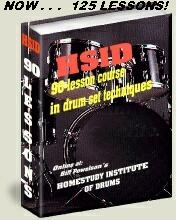Some of you may have already purchased a drum set for your child. That's fine. Almost any drum set will do, at this stage of the game. Just be sure that your tyke can reach the pedals. Lower the drum throne (stool) and all the drums, to the necessary height of your student. The quality of your drumset, whether it's great or very low, isn't much of an issue at all, right now.
Others of you may be contemplating what to do about this issue. Should you purchase drums?
When? At what point should you make an informed purchase?
The truth is . . . If your child can find and clap along in-time with the backbeat flow of most songs, the odds are very good that he or she will do very well at the drum set. I'd say, it's ok, and probably VERY wise, to purchase something inexpensive, once that ability has been determined.
I do NOT recommend an expensive drum set. I tend to favor the little, inexpensive 'Jr.' drum sets, in a very big way. They're pefect for small tykes in the 3 to 7 year old, age range; Especially if the student is small in stature.
At this point, a small inexpensive drum set is more toy, than instrument. Go ahead a pick-up one of the Junior drum sets if you can find something reasonable at the local discount, or department store.
If the stores in your neighborhood don't carry those small Jr. sets, check with nearest local music store. They can always order them, if they do not have them in stock. Explain to the (probably agressive) salesman, your child's age, and size. Otherwise . . . the average salesman may try to sell you the whole store. Tell him you only want a durable 'toy'. Buy the type that has plastic drumheads. Do NOT buy the type that uses cardboard drum heads.
REMEMBER, you'll need an online connection before clicking the links below, and remember to click the BACK BUTTON, when you are ready to return to this page.
PURCHASING TIPS: Try to get a discount on the rig being purchased, if you can. See my 'Buyer's Guide' for tips on how to do that. The Buyer's Guide, I'm linking to, was written for older students (over age 8.) You do not need one of the larger drum sets we're discussing there. Still . . . the BUYING TIPS, may help save you a few dollars.
Also; Don't expect these smaller, cheaper sets to last forever. They won't! They're actually built VERY cheaply. The pedals usually break fairly soon after the purchase. If that happens, just replace the plastic pedal with a more professional foot pedal, from a music store.
As various items break, replace them one-at-a-time, with better, higher quality, items . . . if your child is still wanting to play.
The cymbals they sell with those little sets are absolutely horrible. As soon as you have the money, you will probably want to add a better cymbal. The whole idea here is to give a kid a starting place without dropping a bundle of money.
Incidentally; Many of the small, Junior drum sets, do not come with a Hi-hat. The Hi-hat is very important. We drummers tend to use it 95% of the time. Still, if your chosen set doesn't include a hi hat, do not dispair. Just have your child play on the small (lousey) little cymbal that does come with those sets. A nice Hi-hat will make a nice addition to the set later, if your child remains interested in playing. Hi-Hats are VERY expensive! Take your time on making that purchase, if necessary. Meanwhile . . . just make-do with whatever is included with the set you've purchased.
ANOTHER (MUCH CHEAPER) SOLUTION:
If you can not afford even the toy Junior drumsets right away, you could wait awhile, and just make a VERY inexpensive drumset, from cardboard boxes as I explain in this linked lesson, MAKESHIFT DRUM SETS. This option won't cost much at all! Build a 'makeshift practice set', yourself with free cardboard boxes, available at almost any grocery store.
I prefer the easier and cheaper cardboard set (bottom of the page), over the one made of wood, in the first diagram, at the top of the page.
The cardboard boxes can be tweaked to SOUND like real drums, where it's more difficult to do that on a wooden set. My own first drum set, was made of cardboard, much like the one in the diagram at the bottom of the page. I built it myself at around age 11. It worked for me!
PART II: Getting to Know the Various Parts of a Drum Set
NEXT . . .
Familiarize yourself with all the various parts of a normal drum set. The average drum set usually consists of a Bass drum, a Snare drum, two or three Tom Toms, a Hi-hat with Cymbals, and maybe a small Crash and/or a Ride Cymbal.
THE VARIOUS PARTS OF A DRUM SET: Here's a lesson that describes all those various parts of the set. Get these names into your own head if they aren't already there.
Then, once you get your child's set home from the store . . .
you'll want to point to each item in the set, and say the various names, over and over, until the child can remember each one.
Even if you opt for the cheaper, cardboard 'Makeshift' Drum set, you'll still want the child to learn the names of each item in the set.
WHAT'S NEXT?
Our next challenge is to find ways to teach any small child to eventually coordinate, beat and roll patterns, at the drum set.
Your next lesson: Teaching Coordination.
Finite To Infinity
3 very important questions
IS IT POSSIBLE THAT YOUR 'NATURAL GIFT' OF RHYTHM CAN BE DOUBLED WITH ONLY A LITTLE ADDITIONAL (PREVIOUSLY UNAVAILABLE), KNOWLEDGE?
IS THERE A 'KNOWLEDGE GAP' IN YOUR OWN UNDERSTANDING OF 'RHYTHM'?
IS IT POSSIBLE TO GAIN A COMPLETE AND THOROUGH UNDERSTANDING OF 'ALL RHYTHM', WITHIN ONLY A COUPLE HOURS OF EASY, AND FASCINATING, STUDY ?
Answers: YES! YES! YES!
Get All Products Here

GET ALL THE PRODUCTS AT ONE LOW PRICE.
SURPRISES ABOUND!!!! . . . For those with a bit of generosity in their soul.
CLICK HERE , to see what I mean.
Intermediate & Advanced Drummers
- Drum Instructors Wanted
- Teach My Lessons and Methods
- Up to $60.00/hour
Pre-School Drummer?
Can we teach rhythm to pre-schoolers? YES!
This is a very short course, designed to help adults plant the seeds of rhythm into children of nearly any age. Click Here!!
Make CASH $$$ Now!!!

FREE ELECTRONIC BOOK BONUS (also included) BUSINESS OPPORTUNITY:
- * MAKE BIG MONEY SELLING USED DRUMSETS!
- * INSIDER HARDBALL-BUYING-TIPS AND SECRETS.
- * UNIQUE RECOVERING SECRETS
Support Us Today!!
Support this site and and gain an advetising bargain with the deal. Place a permanent ad here.
